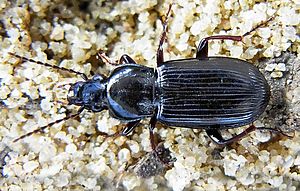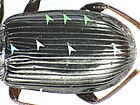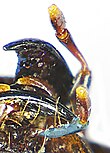Cabbage black grave runner
| Cabbage black grave runner | ||||||||||||
|---|---|---|---|---|---|---|---|---|---|---|---|---|

Cabbage black grave runner |
||||||||||||
| Systematics | ||||||||||||
|
||||||||||||
| Scientific name | ||||||||||||
| Pterostichus anthracinus | ||||||||||||
| ( Illiger , 1798) |
The coal- black grave runner , also called anthracite grave runner , ( Pterostichus anthracinus ) is a beetle from the large family of ground beetles and the subfamily Pterostichinae. The species Pterostichus anthracinus belongs to the subgenus Pseudomaseus and is represented in Europe with four subspecies . In Central Europe the species is represented by the nominate form Pterostichus anthracinus anthracinus . DNA investigations show a close relationship between Pterostichus anthracinus and Pterostichus nigrita and Pterostichus rhaeticus .
The generic name Pterostichus from ancient Greek πτερόν 'pterón' 'wing' and στίχος 'stíchos' 'line' refers to the clearly grooved elytra. The species name anthracinus from Latin anthracīnus means 'coal black' and denotes the body color.
Characteristics of the beetle
The 9.5 to twelve millimeter long beetle is glossy black, only the appendages are more or less lightened brown.
The head with the strong upper jaws is stretched forward. The penultimate link of the lip switch (Fig. 5 blue) has only two bristles. The eleven-limbed antennae (Fig. 1) are turned in front of the curved eyes and are finely haired from the fourth limb. The base link is not compressed.
The pronotum is slightly wider than it is long. On the sides it is arched outwards, just before the right-angled rear corners it is slightly concave. Its rear edge is slightly wider than the front edge. At the base of the pronotum there are two longitudinal impressions that flow together. The outer longitudinal impression (Fig. 6 right green) is shorter and wider than the inner one (Fig. 6 right blue), both are roughly wrinkled. The outer impression is separated from the sidebar by a smooth bead (Fig. 6 right red), which is twice as wide as the sidebar (Fig. 6 right purple). The pronotum has a center line that goes out towards the head. At the beginning of the last third it deepens and ends just before the base of the pronotum.
The elytra are clearly furrowed, the intervals between the furrows moderately arched. As is usual with ground beetles, the wing covers have numerous tactile bristles that arise from pore points . In all species of the genus, there are many umbilical points with tactile bristles (umbilical points, some of which are marked by green arrowheads in Fig. 4) in the eighth groove, which is also the penultimate one. In Pterostichus anthracinus there are three pore points with tactile bristles in the third interval, the first after a quarter of the wing length, the second slightly in front of the middle and the third before the fall (Fig. 4, white arrowheads). A strongly shortened furrow (scutellar streak) runs parallel to the label , at the beginning of which there is another pore point at the base of the wing (Fig. 4, green arrowhead). In the females, the wing cover seam ends in a point, at the side of which the wing covers are slightly shortened (Fig. 7).
In both sexes, the hind wings may be stunted or they may be present and functional. The short-wingedness is inherited regardless of gender and simply dominant , so long-winged forms are homozygous recessive.
The legs are relatively slender for ground beetles. The thigh ring of the hind legs (colored green in Fig. 3) is strikingly large. The tarsi are all five-limbed and on the upper side without a median longitudinal furrow (Fig. 2), in the males the tarsi of the front legs are widened. The claw links are also bare on the underside (Fig. 3).
As with all ground beetles, only six parts of the abdomen can be seen from below. The last (anal star) is indented lengthways oval in the male.
biology
The species is moisture-loving and occurs in floodplains and standing waters. The beetle can be found in moss, plant detritus, under bark, in flood genitals, and other moist places, both in open terrain and in forest. They prefer more humid locations in summer and drier locations in autumn, which can also be far from the water.
Larva and imago are predatory. In breeding, they can easily be fed with freshly cut earthworms, but they show cannibalistic tendencies. The species overwinters as an imago in relatively dry places under moss. In spring, more humid areas are sought for reproduction. The eggs are laid about twenty days after copulation. The development from egg to imago takes an average of a little over a month. A simple type of brood care is that the females guard the eggs that have been deposited in a pit until the larvae hatch.
The adults are nocturnal. The proportion of flight animals fluctuates extremely between different populations. It is believed that the proportion of winged forms is large in young populations, but that the proportion of wingless forms increases with age.
distribution
The species is distributed from the Pyrenees across Europe to the Caucasus and Iran . No find data are available from Norway and Finland .
literature
- Heinz Joy, Karl Wilhelm Harde, Gustav Adolf Lohse: The beetles of Central Europe . tape 2 . Adephaga 1. Elsevier, Spektrum, Akad. Verl., Munich 1976, ISBN 3-87263-025-3 .
- Klaus Koch: The Beetles of Central Europe Ecology. 1st edition. 1, Spectrum Academic Publishing House; Edition: 1 (January 1, 1989), ISBN 978-3827406903 .
- Thomas Götz: Key to the proven and potentially occurring ground beetle species in the district of Constance as PDF
Individual evidence
- ↑ a b Pterostichus anthracinus in Fauna Europaea. Retrieved March 23, 2012
- ↑ Pterostichus anthracinus anthracinus in Fauna Europaea. Retrieved March 25, 2012
- ↑ Michael J. Raupach, Jonas J. Astrin, Karsten Hannig, Marcell K. Peters, Mark Y. Stoeckle, Johann-Wolfgang Wägele: Molecular species identification of Central European ground beetles (Coleoptera: Carabidae) using nuclear rDNA expansion segments and DNA barcodes Raupach et al. Frontiers in Zoology 2010, 7:26 am as PDF
- ↑ Sigmund Schenkling: Explanation of the scientific beetle names.
- ↑ a b C. H. Linroth (1946): "Inheritance of wing dimorphism in Pterostichus anthracinus ILL." Hereditas, 32: 37-40. doi : 10.1111 / j.1601-5223.1946.tb02769.x as PDF
- ↑ J. Andersen: Winter quarters of wetland ground beetles (Coleoptera, Carabidae) in South Scandinavia J Insect Conserv (2011) 15: 799-810 doi : 10.1007 / s10841-011-9378-7
- ↑ FN Kolesnikov: " Pterostichus (Pseudomaseus) anthracinus (Coleoptera, Carabidae) in the Desna river floodland plane: sex and age structure of the population, developmental biology and parental care" Entomological review Vol. 88, No. 8 pp. 904-909 , doi : 10.1134 / S0013873808080034 .
- ↑ Brigitte Henatsch Theo Blick: On the daily running activity of ground beetles, rophies and spiders in a hedge and an adjacent fallow area (Carabidae, Staphylinidae, Araneae) Mitt. Dtsch. Ges. Gen. Angew. Ent. 8 Gießen 1993 pp. 529-536 as PDF
- ↑ David W. Langor, David J. Larson: "Alary polymorphism and life history of a colonizing ground beetle Bembidion lampros Herbst (Coleoptera: Carabidae)". The Coleopterists Bulletin 37 (4), pp. 365-377, 1983 as PDF






